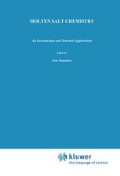Abstract
Why is it important to understand the thermodynamic properties of molten salt solutions, and what aspect of these properties is most important? In technologies and sciences where molten salts, slags or magmas are used or studied, one often must calculate the extent of a chemical reaction or of phase equilibria. In order to do this we need to know an equilibrium constant which can be generally written as
The equilibrium constant K is a function of compositions and activity coefficients, the two quantities necessary to define chemical potentials, μ.
Access this chapter
Tax calculation will be finalised at checkout
Purchases are for personal use only
Preview
Unable to display preview. Download preview PDF.
References
Stull, D. R., and Prophet, H., JANAF Thermochemical Tables, Nat’l.Stand. Ref. Data Ser., Nat’l. Bureau of Standards 37, 2nd edition and supplements (1971).
Barin, I., and Knacke, O., Thermochemical Properties of Inorganic Substances, Springer-Verlag, Berlin, (1973)
Barin, I., Knacke, O., and Kubaschewski, O., Supplement, Springer-Verlag, Berlin (1977).
Robie, R. A., Hemingway, B. S., and Fisher, J. R., Thermodynamic Properties of Minerals, United States Geological Survey Bulletin 1452, U.S. Gov’t. Printing Office, Washington, D.C. (1978).
Pankratz, L. B., Thermodynamic Properties of Elements and Oxides, United States Bureau of Mines Bulletin 672, U.S. Gov’t. Printing Office, Washington, D.C. (1982); Thermodynamic Properties of Halides, United States Bureau of Mines Bulletin 674, U.S. Gov’t. Printing Office, Washington, D.C. (1984); Thermodynamic Data for Mineral Technology, United States Bureau of Mines Bulletin 677, U.S. Gov’t. Printing Office, Washington, D.C. (1984).
Blander, M., “Thermodynamic Properties of Molten Salt Solutions,” in Molten Salt Chemistry, M. Blander, ed., Interscience, NY, pp. 127–237 (1964).
Forland, T., Chapter 2 in Fused Salts, B. L. Sundheim, ed., McGraw Hill, NY (1964).
Lumsden, J., Thermodynamics of Molten Salt Mixtures, Academic Press, NY (1966).
Forland, T., “On the Properties of Some Mixtures of Fused Salts,” Norges Tekn. Vitenskapsakademi, Ser. 2, No. 4 (1957).
Kucera, G. H. and Saboungi, M.-L., Metall. Trans., 7B, pp. 213–215 (1976).
Blander, M., J. Chem. Phys., 34, pp. 432 (1961).
Blander, M. and Saboungi, M.-L., Acta Chemica Scandinavica, A34, pp. 671 (1980).
Curtiss, L. A. and Blander, M., J. Electrochem. Soc., 131, pp. 2271–2274 (1984).
Wai, C, and Blander, M., Z. Naturforschung, 39a, pp. 499 (1984).
Blander, M., Saboungi, M.-L. and Cerisier, P., Metall. Trans., 10B, pp. 613 (1979).
Saboungi, M.-L., Cerisier, P. and Blander, M., Metall. Trans., 13B, pp. 429 (1982).
Saboungi, M.-L. and Blander, M., J. Electrochem. Soc., 122, pp. 1631 (1975).
Alcock, C. B. and Richardson, F. D., Acta Met., 6, pp. 385 (1958); ibid 8, pp. 882 (1960).
Wagner, C, Acta Met., 21, pp. 1297 (1973).
Flood, H. and Grjotheim, K., J. Iron and Steel Inst., London, 171, pp. 64–70 (1952).
Blander, M. and Pelton, A. D., “Analyses and Predictions of the Thermodynamic Properties of Multicomponent Silicates,” in Second Int’l. Symp. on Metallurgical Slags and Fluxes, H. A. Fine and D R. Gaskell, eds., TMS-AIME, Warrendale, PA, pp. 295–304 (1984).
Author information
Authors and Affiliations
Editor information
Editors and Affiliations
Rights and permissions
Copyright information
© 1987 D. Reidel Publishing Company, Dordrecht, Holland
About this chapter
Cite this chapter
Blander, M. (1987). Thermodynamic Properties of Molten Salt Solutions. In: Mamantov, G., Marassi, R. (eds) Molten Salt Chemistry. NATO ASI Series, vol 202. Springer, Dordrecht. https://doi.org/10.1007/978-94-009-3863-2_2
Download citation
DOI: https://doi.org/10.1007/978-94-009-3863-2_2
Publisher Name: Springer, Dordrecht
Print ISBN: 978-94-010-8217-4
Online ISBN: 978-94-009-3863-2
eBook Packages: Springer Book Archive

